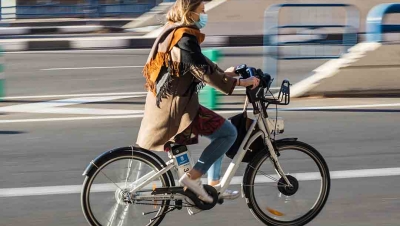Designing Bike Trails - Butch DeFillippo
Bike trails offer citizens a multitude of valuable benefits. They act as corridors that wind through our communities connecting neighborhoods, attractions, business districts, and landscapes. Bike trails are a critical element of a comprehensive recreational system. Trails allow a diverse range of users to participate at their own speeds, scale, and preference. More than that, bike trails entice the average person to reconnect to nature, experience the outdoors, and promote physical activity. Additionally, bike trails encourage movement and mobility, serving a separate function as a means of transportation.
“Nothing compares to the simple pleasure of a bike ride.” John F. Kennedy, U.S. President
What does this mean for our Parks and Recreation departments? Bike trails are some of our greatest assets, but due to their complex nature, they can easily be marginalized and are prone to underfunding. Here are three ways to reframe the idea and refresh your thinking about bike trails.
Plan
Long term planning should be the beginning point for any bike trail system. If we do not know where we want to go, we are a lot less likely to get there. Visioning is a key component of a solid long-term plan. Through the planning process, we can identify goals, objectives, and strategies for creating a healthy and viable trail system. Planning is a great way to realize budget and logistical constraints and political obstacles as well as discovering the needs and wants of our users. Climate change and other environmental concerns also play a role in long-term planning; these issues grow more evident with every passing year. In addition, planning clarifies and prioritizes issues such as alignment and property acquisition, and provides a platform to use demographic data effectively. By providing a clearer understanding of end users, planning reduces the potential for conflict later down the road. Devoting time and effort into the planning process covers our bases from the get go, ensuring a conscientious, well-designed and managed project from the start.
Protect
Long term physical protection of our trails is critical. Ensuring that our bike trail system remains in good working order and is designed efficiently and holistically is important to our stewardship’ssuccess. To do this, we must rely on our organizational staff as well as users to let us know when something is amiss along our trails. Addressing maintenance, cleanliness, and security issues in a timely manner is part of the equation. Likewise, there are multiple design components to an excellent trail system. Be sure to consider the following when thinking about design elements for a complete bike trail system:
- Pedestrian and area level lighting
- Fencing and barrier plantings
- Security stations
- Fitness equipment
- Multi-use paving or demarcation painting
- Signage
- Water availability
- Emergency vehicle and staff access
Additionally, a successful bike trail system may allow for:
- Wildlife habitat and corridor restoration
- Stormwater and flood management
- Utility Right-of-Way
Complete bike trails function as a way to secure our investment, provide a superior community service, increase property values, and enrich our communities. High-quality design elements and commitment to maintenance and security are the best ways to protect and expand the life cycle of our bike trail system.
Engage
Perhaps the most key component to a successful bike trail system is engagement. Above all else, we must value and respect our users and get their support. A loved system has permanence. Commitment from the community is the best way for our trail systems to withstand economic stress and disaster recovery. We must endeavor to foster commitment and community spirit for our trails. Let us use our resources wisely to consistently educate and involve our neighbors. If we prioritize community ownership, we will sustain a stable and successful bike trail.
Standards
The AASHTO Bike Guide is recommended as a minimum set of guidelines for bicycle transportation facilities and shared use paths, but not for bicycle trails intended for rough terrain mountain bike use. This resource is commonly used as the best standard for American bike trail design. The American Association of State Highway and Transportation Officials, Guide for the Development of Bicycle Facilities, 1999 (AASHTO Bike Guide); $85 (AASHTO members $72). AASHTO, 444 North Capitol St NW, Washington DC 20001, phone 202-624-5800, fax 202-624-5806, https://bookstore.transportation.org/.
The Pedestrian and Bicycle Information Center (http://pedbikeinfo.org) has links and direct access to a multitude of bike trail design standards and guidelines in addition to a large library of case studies.
Most states also have their own set of trail design standards and guidelines. Follow up with your state Department of Transportation or local municipal planning departments or organizations for access to these resources.
Organizations
The National Trails Training Partnership (http://www.NTTP.net) has resources on trail planning, design, construction, maintenance, operation, and management. Hosted by http://americantrails.org
The National Center for Bicycling and Walking has resources for pedestrian and bicycle transportation. http://www.bikewalk.org
The Rails to Trails Conservancy www.railstotrails.org, based out of Washington D.C., has many resources not only for design, but for funding and advocacy as well.
The Adventure Cycling Association, www.adventurecycling.org, advocates for and empowers people to use bicycle transportation.
USA Cycling has a list of Cycling Advocacy Organizations across the country. Check out their website at http://www.usacycling.org/cycling-advocacy-organizations.htm for access to bike organizations near you.
Written by Butch DeFillippo With Special Guest Nicholas John Fazio – PlaySafe, LLC Planning Team Specialist
In 1997, a group of Parks and Recreation, Physical Education and private recreation professionals formed PlaySafe, LLC to provide resources that were not readily available to the public and private sectors. Today, PlaySafe, LLC is the largest, most respected and highly skilled playground, surfacing and ball field safety auditing firm in the United States. Our staff members are experts in playground safety, athletic field testing, bleacher inspections, master plans, feasibility studies and program development. Our training and seminars are informative and will make your organization the best it can be. PlaySafe, LLC staff includes Parks and Recreation, Physical Education and Community Health professionals with over 200 years of combined experience.








Bike Paths
Try using colored surfacing for areas that get a lot of attention or in the "spotlight" It gives the path a professional look and distinguishes it quite clearly. Added feature is traction and any striping that might be required will really stand out. It is not much more than a seal coat.
Ed Kruse
Trueline 951-817-0777